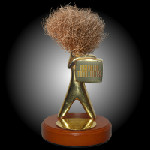Wine time
Here’s what you feel like on a Monday morning: wine – and lots of it. Failing that, there’s the web series Wine, a bottle shared is a problem halved, created by and starring Jess Harris (Twentysomething) and Emily Taheny (Mad As Hell), in which two friends, Harry and Bridget, meet regularly in inner Melbourne bars to talk through their problems over several bottles of white. There are only four episodes and they were released on Facebook earlier this year, so it’s an easy watch.
Just don’t expect Sex and the City or Absolutely Fabulous, this is much more lo-fi and a slow burn. Probably too slow a burn, for if there’s one big problem with this series it’s that you have to wait until the final episode for anything really funny or interesting to happen.
The first three episodes are basically the same – the two women complaining about weird and wonderful aspects of their personal lives whilst steadily getting drunker in a hip bar. There’s some funny dialogue in there, and its well-played and well-paced, but it’s not super hilarious. Also, and unlike other shows working in this area (let’s use Sex and the City and Absolutely Fabulous as examples again) neither Harry or Bridget seem to have a character beyond “woman getting drunk”, which makes it a bit one-note – and means there’s little potential for anything interesting to develop.
Except that it does, in episode four, thanks to a cameo from Ryan Shelton, who plays a sommelier and improves things hugely. Unlike the waiters from previous episodes, who didn’t have much to do other than bring the bottle over or take the women’s money, Shelton’s character actually has a character. And funny lines, which he plays brilliantly.
And to say something (that should be) really obvious, it’s because there’s suddenly a different character in the show that the show’s suddenly a lot funnier. Instead of “two increasingly drunk women who are basically the same, talking about much the same thing” it’s “over-zealous wine waiter” vs. “two increasingly drunk women who just want to be left alone”. I.e. there’s now some conflict, and, therefore, lots of potential for comedy.
The end of episode four is a good one and makes you want to see more of this show, assuming it carries on the same vein. There’s also a lesson here: if you have a comedy with two characters talking to each other, either the two characters need to be sufficiently different and/or interesting to make things funny, or you need to introduce a third character who can be funny. In fact, ideally, you have both.

